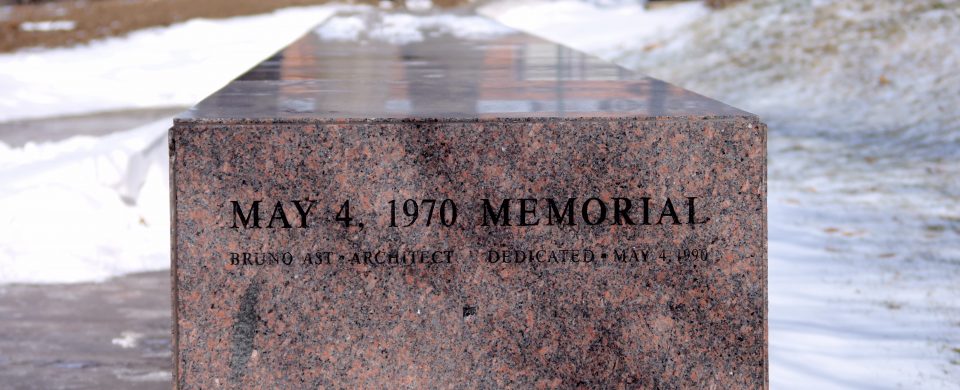Four dead in Ohio - fifty years on
Fifty years ago, as now, many colleges and universities across America were shut down – but the cause then was a contagion of a political rather than viral nature.
Anti-war protests had spread to almost every campus after four students were shot dead by the National Guard at Kent State University, Ohio on May 4, 1970.
‘Four dead in Ohio’ sparked the biggest student strike in US history and became the title of a Neil Young song that served as an anthem for the anti-war movement.
US involvement in Vietnam was by 1970 deeply unpopular. Two years earlier, Richard Nixon won the presidency with a promise to end the war. However, once installed in the White House, he continued to deploy more than 400,000 troops in Vietnam and introduced a draft lottery to ensure that they could be replenished as fast as they were killed, injured or exhausted.
The lottery proved to be a precursor to an expansion of the war. On May 1, Nixon announced that US forces had invaded Cambodia. Potential conscripts were in uproar.
At Kent State, students held a rally on a grassy area known as the Commons where they buried a copy of the US Constitution to symbolise the fact that war had never been declared.
A further rally was planned for the following Monday. But, using Friday evening clashes between students and police as a pretext, Kent’s mayor declared a state of emergency and asked Ohio’s Governor to send in the National Guard.
On the Monday, at midday, when around 3,000 students gathered on the Commons, they faced nearly 1,000 Guardsmen armed with military rifles. Their commander ordered the students to disperse. In the mayhem that followed, some guardsmen fired shots at the unarmed students, killing four and wounding nine.
Within hours, the university was shut down, not to reopen for six weeks. Across the US, more than 900 campuses closed as an estimated four million students mounted a nationwide strike. A photograph of a student screaming over one of the dead victims soon became a worldwide symbol of opposition to the war.
Relatives and friends of those killed and injured at Kent State have fought for fifty years for someone to be held to account for the shootings. The Kent State Truth Tribunal has even taken its case to the United Nations.
Those efforts have not been successful, but the deaths were by no means in vain: the Kent massacre did have the effect of intensifying resistance to the draft and helping to bring the war to an end in 1975.
Washington’s 20-year intervention in South East Asia was fatal for 58,220 US military personnel. When leaked Pentagon papers revealed that successive presidents had lied about US aims and operations in the region, anger about the war spread well beyond those who had protested at the time.
But this, in turn, prompted the US military-industrial complex to look for ways to intervene globally without risking a backlash against the cost in American lives.
The 1980s saw the US fight proxy wars through the Contras in Nicaragua and the Mujahideen in Afghanistan. At the same time, cruise missiles and drones were developed to keep their operatives beyond the reach of retaliation. And now we’re seeing the development of “autonomous weapons” that the arms industry claims can make their own targeting judgements without any human control.
But proxies are getting harder to find and technology has its limits. This was illustrated in January after the US assassinated Iranian general Qasem Soleimani.
Faced with protestors over-running the US embassy in Baghdad, President Trump initially threatened to strike back with “new, beautiful” military equipment. The US, he boasted, had spent two trillion dollars on being “the biggest and by far the best” equipped military power.
But the reality on the ground was that he had to deploy an extra 4,000 troops to Iraq to guard the physical infrastructure of an occupying power.
So far, nearly 5,000 young Americans have died in Iraq since the invasion in 2003. That may be a small proportion of the total death toll of more than 288,000, and less than a tenth of the number that died in Vietnam, but it nevertheless means that virtually every US town and city has felt the deadly cost of the war.
If Washington now has its sights on ‘defeating’ Iran, the number of soldiers needed – even in this era of high-tech warfare – could soar to the six figure levels seen fifty years ago in South East Asia.
But do the US people have an appetite for war? Certainly, Trumps rhetoric on Twitter can produce an outpouring of bloodthirsty posts. But opinion polls suggest that Americans are opposed to war with Iran by a big majority.
The story of the four who died in Ohio is a reminder that war isn’t pain-free, even for the “greatest” power on earth. It comes home, bringing blood over the doorstep.
Steve Howell
Steve is a journalist, campaigner and the author of Game Changer: Eight Weeks That Transformed British Politics.
Order a copy of Game Changer here at the special price of £5.00, inclusive of UK postage. ORDER
Order the Kindle version of Game Changer at £2.99 here. ORDER

